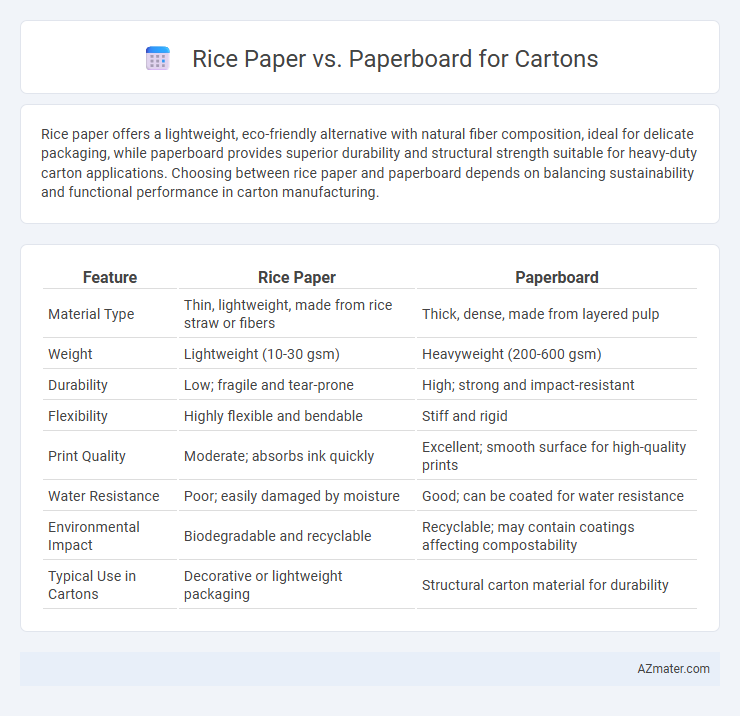Rice paper offers a lightweight, eco-friendly alternative with natural fiber composition, ideal for delicate packaging, while paperboard provides superior durability and structural strength suitable for heavy-duty carton applications. Choosing between rice paper and paperboard depends on balancing sustainability and functional performance in carton manufacturing.
Table of Comparison
| Feature | Rice Paper | Paperboard |
|---|---|---|
| Material Type | Thin, lightweight, made from rice straw or fibers | Thick, dense, made from layered pulp |
| Weight | Lightweight (10-30 gsm) | Heavyweight (200-600 gsm) |
| Durability | Low; fragile and tear-prone | High; strong and impact-resistant |
| Flexibility | Highly flexible and bendable | Stiff and rigid |
| Print Quality | Moderate; absorbs ink quickly | Excellent; smooth surface for high-quality prints |
| Water Resistance | Poor; easily damaged by moisture | Good; can be coated for water resistance |
| Environmental Impact | Biodegradable and recyclable | Recyclable; may contain coatings affecting compostability |
| Typical Use in Cartons | Decorative or lightweight packaging | Structural carton material for durability |
Introduction to Rice Paper and Paperboard Cartons
Rice paper cartons, made from thin, translucent pulp derived from rice straw or other natural fibers, offer lightweight, breathable packaging solutions ideal for delicate or moisture-sensitive products. Paperboard cartons are thicker, more rigid packaging materials created from compressed wood pulp fibers, providing enhanced durability and protection for heavier or bulkier goods. Selecting between rice paper and paperboard cartons depends on product requirements such as protection level, weight, and visual appeal.
Material Composition: Rice Paper vs Paperboard
Rice paper is primarily made from natural fibers like rice straw or other plant materials, offering a thin, lightweight, and flexible texture ideal for delicate packaging. Paperboard, in contrast, consists of multiple layers of paper pulp pressed together to create a thicker, more rigid material suited for structural cartons and heavy-duty packaging. The distinct material composition affects durability, weight, and protective qualities, with rice paper favored for aesthetics and eco-friendliness, while paperboard is preferred for strength and load-bearing capacity.
Environmental Impact and Sustainability
Rice paper, derived from natural plant fibers, offers a biodegradable and compostable alternative to traditional paperboard, reducing landfill waste and promoting eco-friendly packaging. Paperboard, typically made from wood pulp, is recyclable but often involves energy-intensive manufacturing processes and chemical treatments that can impact environmental sustainability. Choosing rice paper for cartons supports lower carbon footprints and renewable resource use, aligning better with sustainable packaging goals.
Strength and Durability Comparison
Rice paper offers lightweight flexibility but falls short in strength and durability compared to paperboard, which provides superior stiffness and resistance to bending. Paperboard's multi-ply construction enhances its ability to withstand pressure and protect contents during shipping and handling. High-density paperboard cartons are preferred for packaging heavy or fragile items due to their increased durability and impact resistance.
Cost Analysis: Affordability and Value
Rice paper offers a more affordable option for lightweight packaging needs, with lower raw material and production costs compared to paperboard. Paperboard provides superior durability and structural integrity, justifying its higher price in applications requiring enhanced protection and shelf presence. Evaluating the total cost of ownership, including material, printing, and transportation expenses, reveals rice paper's value in cost-sensitive markets while paperboard meets premium packaging demands.
Printing Quality and Customization Options
Rice paper offers delicate texture and excellent ink absorption, resulting in vibrant, sharp printing quality ideal for luxury packaging designs, while its thinner nature limits heavy customization and structural durability. Paperboard provides a smooth, consistent surface that supports high-resolution printing with durable finishes, making it suitable for bold graphics and extensive customization such as embossing or foil stamping. Paperboard's rigid composition enhances structural integrity for cartons, offering broader design freedom but often at higher production costs compared to rice paper.
Food Safety and Packaging Suitability
Rice paper offers a natural, biodegradable option for food packaging with excellent grease resistance and breathability, making it ideal for certain fresh and dry foods. Paperboard provides superior durability, moisture resistance, and structural support, which enhances protection and shelf life, essential for heavier or liquid-based food products. Both materials comply with food safety regulations, but paperboard's barrier properties and customizable coatings offer broader suitability for diverse packaging needs.
Moisture Resistance and Protection
Rice paper offers moderate moisture resistance, suitable for lightweight packaging but can absorb humidity, which compromises protection over time. Paperboard provides superior moisture resistance due to its denser fiber structure and often includes coatings or laminates that enhance barrier properties. For cartons requiring enhanced durability and protection against damp environments, paperboard is the optimal choice.
Popular Applications in Packaging Industry
Rice paper is widely used for packaging delicate food items like candies, sushi, and dim sum due to its edible, biodegradable, and moisture-resistant properties. Paperboard excels in packaging applications requiring structural stability and protection, such as cereal boxes, cartons for frozen foods, and retail packaging. Both materials are favored in the packaging industry for eco-friendly solutions, with rice paper preferred for lightweight, single-use wraps and paperboard for durable, protective containers.
Conclusion: Choosing the Right Carton Material
Rice paper offers a lightweight, eco-friendly option ideal for packaging sensitive, low-weight products, while paperboard provides superior durability and structural strength suitable for heavier or bulkier items. Selecting the right carton material depends on product weight, protection requirements, and sustainability goals, with paperboard favored for robust packaging and rice paper for biodegradable, minimalistic solutions. Assessing factors such as product fragility, shelf life, and environmental impact ensures optimal carton performance and customer satisfaction.

Infographic: Rice paper vs Paperboard for Carton
 azmater.com
azmater.com